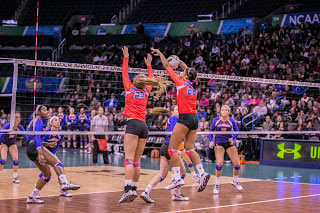|
A Drill to Improve Quick Hitting By: Gregory Shell - Assistant Coach - Central Connecticut State University Provided By: - American Volleyball Coaches Association
The drill format requires 2 passers, 2 setters, 3 Middles, 1 Coach or player to initiate the drill, and 1 Coach or player to score it. The setup is a Middle, Setter, and passer on each side of the net. The person initiating the drill sends a free ball to the passer on one side. The ball is passed to the Setter, who sets a "1" for her Middle, who must swing-no tipping is allowed. The opposing Middle attempts to block the attack. The person initiating then tosses a free ball to the second Middle, and she attacks against the first Middle. This is one complete rep. After 3 reps, the Middles switch sides (so there is no advantage in working off of one particular passer/Setter combination), and they complete 3 more reps to finish off the first round.
Since this is a "round robin" drill, there are a total of 3 rounds, Middle A vs. Middle B, B vs. C, and A vs. C. Middle A has a pretty clear advantage, with the break of the second round to rest...the pace the drill is run at can have a significant impact on the outcome-deliberately paced gives a more realistic comparison between your Middles.
The most interesting variable in the drill is the scoring. This can be adjusted to reflect your individual preferences; it can emphasize offense, defense, or a combination of both. The following scoring system is solely offense based: the offense scores 2 for a clean kill, 1 for a kill off the block, 0 for a ball hit off the block that the defense should be able to play, 0 for a blocked ball, and -1 for a ball hit directly out of bounds or into the net. Defense does not score, but does prevent the offense from scoring. (If you want to stress this as a "2 way" drill, +1 to the defense for a block, but be sure to balance it out-a net violation on D should score as -1 for the Defensive Middle, to keep everyone honest.) Outside of adjusting the scoring format, there is one variation that you can make depending on your personnel. If there is one Setter that is much stronger than the others, and you want a better read on her connection with your Middles, the same Setter can set both sides of the drill. A slow pace is critical if you use this variant, or you will have one very tired, very dizzy Setter. I wouldn't recommend this drill as a starting place for training the Middle position or the quick attack-it is more of a measuring stick to gauge the Middles' progress and relative ability. It will give you some comparative player data (on not only your Middles performance, but also the Setters' ability to set a good quick to each hitter if you choose to track it), a very competitive positional environment, and probably a few highlight kills along the way. Happy (Quick) Hitting!
|










